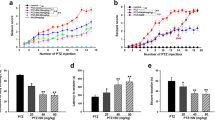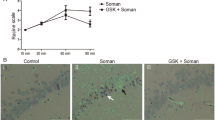Abstract
Epilepsy is one of the most common diseases of the central nervous system. Recent studies have shown that a variety of inflammatory mediators play a key role in the pathogenesis of the disease. Ibuprofen (IBP) is a well-known anti-inflammatory agent that reduces the neuroinflammatory response and neuronal damage. In this study, we examined the effect of IBP in a rat model of pentylenetetrazol (PTZ)-induced chronic epilepsy. PTZ injection was given a total of 15 times on alternate days (over a period of 29 days) to induce epilepsy. The effects of IBP were evaluated by behavioral observation, EEG recording, Nissl staining, immunohistochemistry, Western blot analysis, and electrophysiological recording. The results showed that IBP alone affected the expression of cyclooxygenase-2 (COX-2) and neuronal excitability but did not cause epilepsy. IBP reduced seizure scores in the PTZ-treated rats, and it minimized the loss of hippocampal neurons. In addition, IBP decreased the secretion of COX-2, inhibited the activation of the NOD-like receptor 3 inflammasome, and reduced the secretion of the inflammatory cytokine interleukin-18. Furthermore, the results of whole-cell patch-clamp revealed that IBP affected action potential properties, including frequency, latency and duration in epileptic rats, suggesting that it may impact neuronal excitability. These effects of IBP may underlie its antiepileptic and neuroprotective actions.







Similar content being viewed by others
References
Rana A, Musto AE (2018) The role of inflammation in the development of epilepsy. J Neuroinflamm 15(1):144
Mazarati AM, Lewis ML, Pittman QJ (2017) Neurobehavioral comorbidities of epilepsy: role of inflammation. Epilepsia 58(Suppl 3):48–56
Malik A, Kanneganti TD (2017) Inflammasome activation and assembly at a glance. J Cell Sci 130(23):3955–3963
Rathinam VAK, Fitzgerald KA (2016) Inflammasome complexes: emerging mechanisms and effector functions. Cell 165(4):792–800
Shao BZ, Xu ZQ, Han BZ et al (2015) NLRP3 inflammasome and its inhibitors: a review. Front Pharmacol 6:262
Han X, Sun S, Sun Y et al (2019) Small molecule-driven NLRP3 inflammation inhibition via interplay between ubiquitination and autophagy: implications for Parkinson disease. Autophagy 15(11):1860–1881
Li L, Ismael S, Nasoohi S et al (2019) Thioredoxin-interacting protein (TXNIP) associated NLRP3 inflammasome activation in human Alzheimer’s disease brain. J Alzheimers Dis 68(1):255–265
Gugliandolo A, Giacoppo S, Bramanti P et al (2018) NLRP3 inflammasome activation in a transgenic amyotrophic lateral sclerosis model. Inflammation 41(1):93–103
Rong S, Wan D, Fan Y et al (2019) Amentoflavone affects epileptogenesis and exerts neuroprotective effects by inhibiting NLRP3 inflammasome. Front Pharmacol 10:856
Lai ZZ, Yang HL, Ha SY et al (2019) Cyclooxygenase-2 in endometriosis. Int J Biol Sci 15(13):2783–2797
Rojas A, Jiang J, Ganesh T et al (2014) Cyclooxygenase-2 in epilepsy. Epilepsia 55(1):17–25
Hua KF, Chou JC, Ka SM et al (2015) Cyclooxygenase-2 regulates NLRP3 inflammasome-derived IL-1β production. J Cell Physiol 230(4):863–874
Xue Z, Zhang Z, Liu H et al (2019) lincRNA-Cox2 regulates NLRP3 inflammasome and autophagy mediated neuroinflammation. Cell Death Differ 26(1):130–145
Peng J, Wu S, Guo C et al (2019) Effect of ibuprofen on autophagy of astrocytes during pentylenetetrazol-induced epilepsy and its significance: an experimental study. Neurochem Res 44(11):2566–2576
Sanz-Blasco S, Calvo-Rodriguez M, Caballero E et al (2018) Is it all said for NSAIDs in Alzheimer’s disease? Role of mitochondrial calcium uptake. Curr Alzheimer Res 15(6):504–510
Wixey JA, Sukumar KR, Pretorius R et al (2019) Ibuprofen treatment reduces the neuroinflammatory response and associated neuronal and white matter impairment in the growth restricted newborn. Front Physiol 10:541
Orlando BJ, Lucido MJ, Malkowski MG (2015) The structure of ibuprofen bound to cyclooxygenase-2. J Struct Biol 189(1):62–66
Gao B, Wu Y, Yang YJ et al (2018) Sinomenine exerts anticonvulsant profile and neuroprotective activity in pentylenetetrazole kindled rats: involvement of inhibition of NLRP1 inflammasome. J Neuroinflamm 15(1):152
Wallenstein MC (1991) Attenuation of epileptogenesis by nonsteroidal anti-inflammatory drugs in the rat. Neuropharmacology 30(6):657–663
Chindo BA, Schröder H, Becker A (2015) Methanol extract of Ficus platyphylla ameliorates seizure severity, cognitive deficit and neuronal cell loss in pentylenetetrazole-kindled mice. Phytomedicine 22(1):86–93
Zhu X, Shen K, Bai Y et al (2016) NADPH oxidase activation is required for pentylenetetrazole kindling-induced hippocampal autophagy. Free Radic Biol Med 94:230–242
Altwegg-Boussac T, Schramm AE, Ballestero J et al (2017) Cortical neurons and networks are dormant but fully responsive during isoelectric brain state. Brain 140(9):2381–2398
Zhang X, Wu Q, Zhang Q et al (2017) Resveratrol attenuates early brain injury after experimental subarachnoid hemorrhage via inhibition of NLRP3 inflammasome activation. Front Neurosci 11:611
Si J, Wang S, Liu N et al (2017) Anticonvulsant effect of exogenous β-hydroxybutyrate on kainic acid-induced epilepsy. Exp Ther Med 14(1):765–770
**e Y, Yu N, Chen Y et al (2017) HMGB1 regulates P-glycoprotein expression in status epilepticus rat brains via the RAGE/NF-κB signaling pathway. Mol Med Rep 16(2):1691–1700
Scorza CA, Marques MJG, Gomes da Silva S et al (2018) Status epilepticus does not induce acute brain inflammatory response in the Amazon rodent Proechimys, an animal model resistant to epileptogenesis. Neurosci Lett 668:169–173
Ozaki E, Campbell M, Doyle SL (2015) Targeting the NLRP3 inflammasome in chronic inflammatory diseases: current perspectives. J Inflamm Res 8:15–27
Zendedel A, Johann S, Mehrabi S et al (2016) Activation and regulation of NLRP3 inflammasome by intrathecal application of SDF-1a in a spinal cord injury model. Mol Neurobiol 53(5):3063–3075
Zhang D, Wang X, Wang B et al (2017) Adiponectin regulates contextual fear extinction and intrinsic excitability of dentate gyrus granule neurons through AdipoR2 receptors. Mol Psychiatry 22(7):1044–1055
Shen K, Mao Q, Yin X et al (2018) NLRP3 inflammasome activation leads to epileptic neuronal apoptosis. Curr Neurovasc Res 15(4):276–281
Zhu X, Liu J, Huang S et al (2019) Neuroprotective effects of isoliquiritigenin against cognitive impairment via suppression of synaptic dysfunction, neuronal injury, and neuroinflammation in rats with kainic acid-induced seizures. Int Immunopharmacol 72:358–366
Serdar M, Kempe K, Rizazad M et al (2019) Early pro-inflammatory microglia activation after inflammation-sensitized hypoxic-ischemic brain injury in neonatal rats. Front Cell Neurosci 13:237
Yatsiv I, Morganti-Kossmann MC, Perez D et al (2002) Elevated intracranial IL-18 in humans and mice after traumatic brain injury and evidence of neuroprotective effects of IL-18-binding protein after experimental closed head injury. J Cereb Blood Flow Metab 22(8):971–978
Sil S, Ghosh T (2016) Role of cox-2 mediated neuroinflammation on the neurodegeneration and cognitive impairments in colchicine induced rat model of Alzheimer’s disease. J Neuroimmunol 291:115–124
Vezzani A, Friedman A, Dingledine RJ (2013) The role of inflammation in epileptogenesis. Neuropharmacology 69:16–24
Serrano GE, Lelutiu N, Rojas A et al (2011) Ablation of cyclooxygenase-2 in forebrain neurons is neuroprotective and dampens brain inflammation after status epilepticus. J Neurosci 31(42):14850–14860
Staley K (2015) Molecular mechanisms of epilepsy. Nat Neurosci 18(3):367–372
Navidhamidi M, Ghasemi M, Mehranfard N (2017) Epilepsy-associated alterations in hippocampal excitability. Rev Neurosci 28(3):307–334
Wu K, Leung LS (2003) Increased dendritic excitability in hippocampal ca1 in vivo in the kainic acid model of temporal lobe epilepsy: a study using current source density analysis. Neuroscience 116(2):599–616
Cossart R, Dinocourt C, Hirsch JC et al (2001) Dendritic but not somatic GABAergic inhibition is decreased in experimental epilepsy. Nat Neurosci 4(1):52–62
Unichenko P, Yang JW, Luhmann HJ et al (2015) Glutamatergic system controls synchronization of spontaneous neuronal activity in the murine neonatal entorhinal cortex. Pflugers Arch 467(7):1565–1575
Ozturk Bilgin O, Kumbul Doguc D, Altuntas I, Sutcu R et al (2013) Effects of subchronic treatment with ibuprofen and nimesulide on spatial memory and NMDAR subunits expression in aged rats. Iran J Pharm Res 12(4):877–885
Márquez Loza A, Elias V, Wong CP et al (2017) Effects of ibuprofen on cognition and NMDA receptor subunit expression across aging. Neuroscience 344:276–292
Çarçak N, Ali I, Powell K et al (2019) Ca 3.2 T-type calcium channel mutation influences kindling-induced thalamic neuronal firing patterns in genetic absence epilepsy rats from Strasbourg. Epilepsia 60(7):1378–1386
Yang ZF, Wang HW, Zheng YQ et al (2008) Possible arrhythmiogenic mechanism produced by ibuprofen. Acta Pharmacol Sin 29(4):421–429
Acknowledgements
This work was supported by grants from National Natural Science Foundation of China (to Shuhua Wu, No. 81772637), Shandong Medical and Health Technology Development Plan (to Zhongbo Hu, No. 2017WS553), Binzhou Medical University Science and Technology Plan Project (to Chong Guo, No. BY2015KJ13).
Author information
Authors and Affiliations
Corresponding author
Ethics declarations
Conflict of interest
The authors declare that they have no conflict of interest.
Ethical Approval
All protocols were approved by the Institutional Animal Ethical Committee of Binzhou Medical University Hospital (China), and experiments were performed in accordance to the CPCSEA guidelines for ethical use of animals.
Additional information
Publisher's Note
Springer Nature remains neutral with regard to jurisdictional claims in published maps and institutional affiliations.
Rights and permissions
About this article
Cite this article
Liu, R., Wu, S., Guo, C. et al. Ibuprofen Exerts Antiepileptic and Neuroprotective Effects in the Rat Model of Pentylenetetrazol-Induced Epilepsy via the COX-2/NLRP3/IL-18 Pathway. Neurochem Res 45, 2516–2526 (2020). https://doi.org/10.1007/s11064-020-03109-9
Received:
Revised:
Accepted:
Published:
Issue Date:
DOI: https://doi.org/10.1007/s11064-020-03109-9




